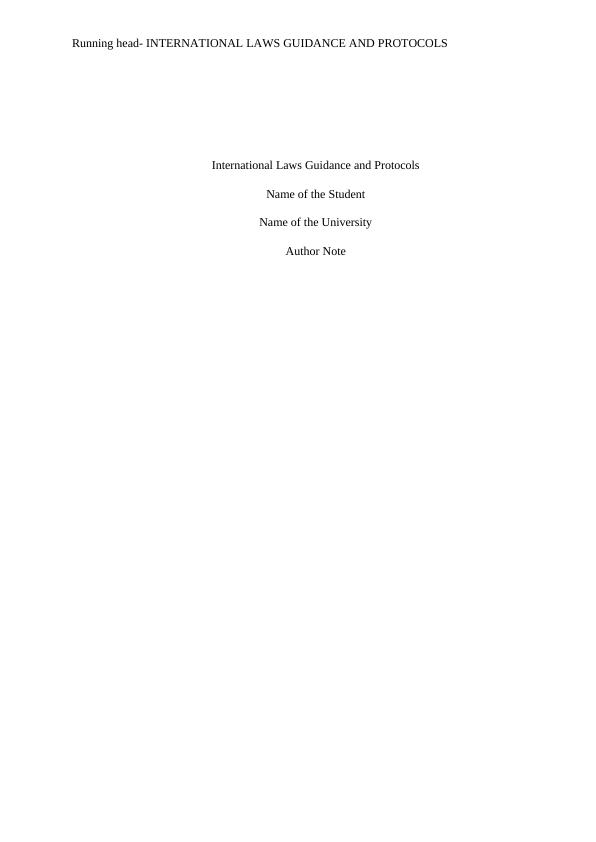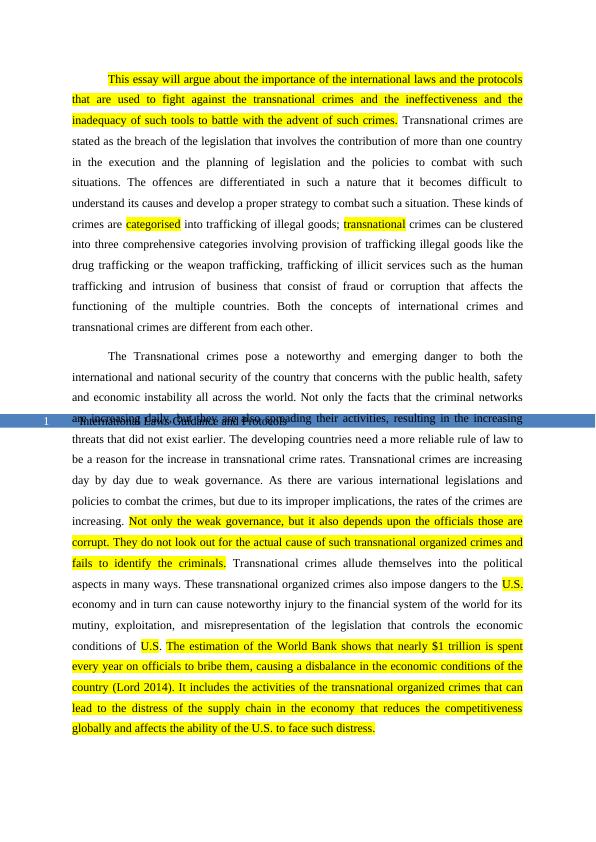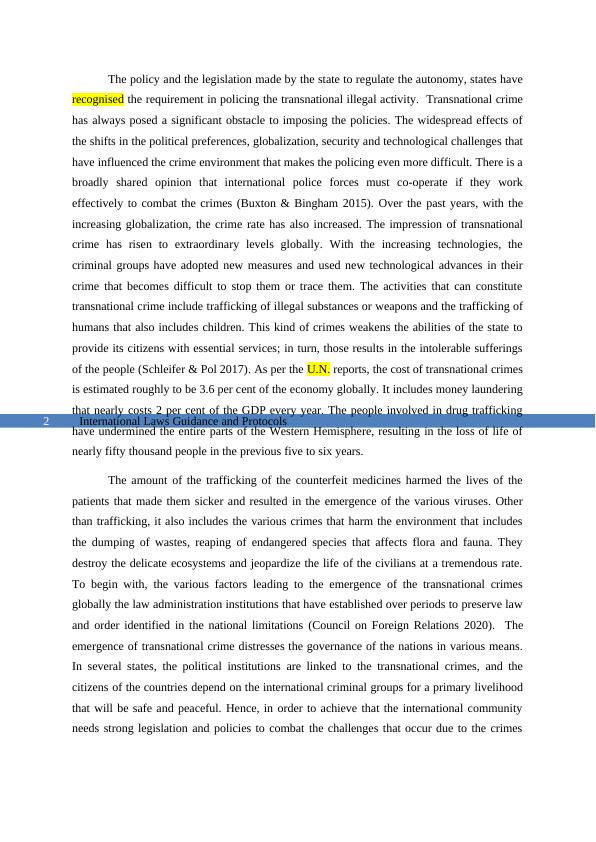International Laws Guidance and Protocols
Added on 2022-08-15
12 Pages4562 Words25 Views
Running head- INTERNATIONAL LAWS GUIDANCE AND PROTOCOLS
International Laws Guidance and Protocols
Name of the Student
Name of the University
Author Note
International Laws Guidance and Protocols
Name of the Student
Name of the University
Author Note

International Laws Guidance and Protocols1
This essay will argue about the importance of the international laws and the protocols
that are used to fight against the transnational crimes and the ineffectiveness and the
inadequacy of such tools to battle with the advent of such crimes. Transnational crimes are
stated as the breach of the legislation that involves the contribution of more than one country
in the execution and the planning of legislation and the policies to combat with such
situations. The offences are differentiated in such a nature that it becomes difficult to
understand its causes and develop a proper strategy to combat such a situation. These kinds of
crimes are categorised into trafficking of illegal goods; transnational crimes can be clustered
into three comprehensive categories involving provision of trafficking illegal goods like the
drug trafficking or the weapon trafficking, trafficking of illicit services such as the human
trafficking and intrusion of business that consist of fraud or corruption that affects the
functioning of the multiple countries. Both the concepts of international crimes and
transnational crimes are different from each other.
The Transnational crimes pose a noteworthy and emerging danger to both the
international and national security of the country that concerns with the public health, safety
and economic instability all across the world. Not only the facts that the criminal networks
are increasing daily, but they are also spreading their activities, resulting in the increasing
threats that did not exist earlier. The developing countries need a more reliable rule of law to
be a reason for the increase in transnational crime rates. Transnational crimes are increasing
day by day due to weak governance. As there are various international legislations and
policies to combat the crimes, but due to its improper implications, the rates of the crimes are
increasing. Not only the weak governance, but it also depends upon the officials those are
corrupt. They do not look out for the actual cause of such transnational organized crimes and
fails to identify the criminals. Transnational crimes allude themselves into the political
aspects in many ways. These transnational organized crimes also impose dangers to the U.S.
economy and in turn can cause noteworthy injury to the financial system of the world for its
mutiny, exploitation, and misrepresentation of the legislation that controls the economic
conditions of U.S. The estimation of the World Bank shows that nearly $1 trillion is spent
every year on officials to bribe them, causing a disbalance in the economic conditions of the
country (Lord 2014). It includes the activities of the transnational organized crimes that can
lead to the distress of the supply chain in the economy that reduces the competitiveness
globally and affects the ability of the U.S. to face such distress.
This essay will argue about the importance of the international laws and the protocols
that are used to fight against the transnational crimes and the ineffectiveness and the
inadequacy of such tools to battle with the advent of such crimes. Transnational crimes are
stated as the breach of the legislation that involves the contribution of more than one country
in the execution and the planning of legislation and the policies to combat with such
situations. The offences are differentiated in such a nature that it becomes difficult to
understand its causes and develop a proper strategy to combat such a situation. These kinds of
crimes are categorised into trafficking of illegal goods; transnational crimes can be clustered
into three comprehensive categories involving provision of trafficking illegal goods like the
drug trafficking or the weapon trafficking, trafficking of illicit services such as the human
trafficking and intrusion of business that consist of fraud or corruption that affects the
functioning of the multiple countries. Both the concepts of international crimes and
transnational crimes are different from each other.
The Transnational crimes pose a noteworthy and emerging danger to both the
international and national security of the country that concerns with the public health, safety
and economic instability all across the world. Not only the facts that the criminal networks
are increasing daily, but they are also spreading their activities, resulting in the increasing
threats that did not exist earlier. The developing countries need a more reliable rule of law to
be a reason for the increase in transnational crime rates. Transnational crimes are increasing
day by day due to weak governance. As there are various international legislations and
policies to combat the crimes, but due to its improper implications, the rates of the crimes are
increasing. Not only the weak governance, but it also depends upon the officials those are
corrupt. They do not look out for the actual cause of such transnational organized crimes and
fails to identify the criminals. Transnational crimes allude themselves into the political
aspects in many ways. These transnational organized crimes also impose dangers to the U.S.
economy and in turn can cause noteworthy injury to the financial system of the world for its
mutiny, exploitation, and misrepresentation of the legislation that controls the economic
conditions of U.S. The estimation of the World Bank shows that nearly $1 trillion is spent
every year on officials to bribe them, causing a disbalance in the economic conditions of the
country (Lord 2014). It includes the activities of the transnational organized crimes that can
lead to the distress of the supply chain in the economy that reduces the competitiveness
globally and affects the ability of the U.S. to face such distress.

International Laws Guidance and Protocols2
The policy and the legislation made by the state to regulate the autonomy, states have
recognised the requirement in policing the transnational illegal activity. Transnational crime
has always posed a significant obstacle to imposing the policies. The widespread effects of
the shifts in the political preferences, globalization, security and technological challenges that
have influenced the crime environment that makes the policing even more difficult. There is a
broadly shared opinion that international police forces must co-operate if they work
effectively to combat the crimes (Buxton & Bingham 2015). Over the past years, with the
increasing globalization, the crime rate has also increased. The impression of transnational
crime has risen to extraordinary levels globally. With the increasing technologies, the
criminal groups have adopted new measures and used new technological advances in their
crime that becomes difficult to stop them or trace them. The activities that can constitute
transnational crime include trafficking of illegal substances or weapons and the trafficking of
humans that also includes children. This kind of crimes weakens the abilities of the state to
provide its citizens with essential services; in turn, those results in the intolerable sufferings
of the people (Schleifer & Pol 2017). As per the U.N. reports, the cost of transnational crimes
is estimated roughly to be 3.6 per cent of the economy globally. It includes money laundering
that nearly costs 2 per cent of the GDP every year. The people involved in drug trafficking
have undermined the entire parts of the Western Hemisphere, resulting in the loss of life of
nearly fifty thousand people in the previous five to six years.
The amount of the trafficking of the counterfeit medicines harmed the lives of the
patients that made them sicker and resulted in the emergence of the various viruses. Other
than trafficking, it also includes the various crimes that harm the environment that includes
the dumping of wastes, reaping of endangered species that affects flora and fauna. They
destroy the delicate ecosystems and jeopardize the life of the civilians at a tremendous rate.
To begin with, the various factors leading to the emergence of the transnational crimes
globally the law administration institutions that have established over periods to preserve law
and order identified in the national limitations (Council on Foreign Relations 2020). The
emergence of transnational crime distresses the governance of the nations in various means.
In several states, the political institutions are linked to the transnational crimes, and the
citizens of the countries depend on the international criminal groups for a primary livelihood
that will be safe and peaceful. Hence, in order to achieve that the international community
needs strong legislation and policies to combat the challenges that occur due to the crimes
The policy and the legislation made by the state to regulate the autonomy, states have
recognised the requirement in policing the transnational illegal activity. Transnational crime
has always posed a significant obstacle to imposing the policies. The widespread effects of
the shifts in the political preferences, globalization, security and technological challenges that
have influenced the crime environment that makes the policing even more difficult. There is a
broadly shared opinion that international police forces must co-operate if they work
effectively to combat the crimes (Buxton & Bingham 2015). Over the past years, with the
increasing globalization, the crime rate has also increased. The impression of transnational
crime has risen to extraordinary levels globally. With the increasing technologies, the
criminal groups have adopted new measures and used new technological advances in their
crime that becomes difficult to stop them or trace them. The activities that can constitute
transnational crime include trafficking of illegal substances or weapons and the trafficking of
humans that also includes children. This kind of crimes weakens the abilities of the state to
provide its citizens with essential services; in turn, those results in the intolerable sufferings
of the people (Schleifer & Pol 2017). As per the U.N. reports, the cost of transnational crimes
is estimated roughly to be 3.6 per cent of the economy globally. It includes money laundering
that nearly costs 2 per cent of the GDP every year. The people involved in drug trafficking
have undermined the entire parts of the Western Hemisphere, resulting in the loss of life of
nearly fifty thousand people in the previous five to six years.
The amount of the trafficking of the counterfeit medicines harmed the lives of the
patients that made them sicker and resulted in the emergence of the various viruses. Other
than trafficking, it also includes the various crimes that harm the environment that includes
the dumping of wastes, reaping of endangered species that affects flora and fauna. They
destroy the delicate ecosystems and jeopardize the life of the civilians at a tremendous rate.
To begin with, the various factors leading to the emergence of the transnational crimes
globally the law administration institutions that have established over periods to preserve law
and order identified in the national limitations (Council on Foreign Relations 2020). The
emergence of transnational crime distresses the governance of the nations in various means.
In several states, the political institutions are linked to the transnational crimes, and the
citizens of the countries depend on the international criminal groups for a primary livelihood
that will be safe and peaceful. Hence, in order to achieve that the international community
needs strong legislation and policies to combat the challenges that occur due to the crimes

International Laws Guidance and Protocols3
and questions the effectiveness of the present legislation and the policies. However, the fact
that they are often politicised hence the data of such crimes remains unknown.
There have been several regional, bilateral and global agreements that are
proliferating that replicate the awareness that the transnational crimes can be addressed only
through international cooperation and with such it can be reduced (Jacobs 2016). Within not
only the national borders but the criminal groups also spread their criminal activities even
across the borders. However, the judicial system of the countries is limited within the
national borders. Therefore, the judiciary should also spread across the national borders like
the transnational crime. There are several conventions and the legal frameworks that the
United States must define address the grave delinquent of like human trafficking. These kinds
of tools offer a legal framework in order to collaborate in the various aspects of the fight
against human trafficking. The Organized crime conventions and the protocols regulate the
trafficking in person and the protocol concerning the migrants in order to combat specifically
with trafficking. However, the Organized Crime Convention and the Trafficking in Persons
Protocol establish a very least standard in order to combat the transnational crimes (Bachaka
2017). The States parties are unlikely to abide by the minimum standards that are not much
effective and in turn, need to adopt the more strict measures. The primary focuses of the
Convention are primarily on offences that are oriented towards the profit-oriented activities
of those kinds of organized criminal groups. These etiquettes act as a supplementary and
require specific and specialized provisions to regulate organized immoral activities. Such
protocols follow upon three fundamental principles including the measures to avoid
trafficking, to protect the victims of illegal trade and to promote cooperation between the
states in order to meet the goals to combat with the crimes such as trafficking. Various other
protocols such as the Migrants Smuggling Protocol aim at prevention of smuggling of the
migrants and promote cooperation among the states to reduce such crimes (International
framework 2014). In addition to the requirement for such specific legislation and the
protocols to operate such activities, specific laws and legislations must be made stronger.
Laws shall be made in accordance to the functioning that would not hamper the flow of the
justice and maintain the stability within the nation and across the nation.
The various international determinations to discourse the transnational organized
crime are very fragile in order to diminish the threats that it suffers (Merle 2014). On
balancing the multidimensional inventiveness to battle and they attempt to take legal action
against the transnational organized crimes without adequately addressing them. The central
and questions the effectiveness of the present legislation and the policies. However, the fact
that they are often politicised hence the data of such crimes remains unknown.
There have been several regional, bilateral and global agreements that are
proliferating that replicate the awareness that the transnational crimes can be addressed only
through international cooperation and with such it can be reduced (Jacobs 2016). Within not
only the national borders but the criminal groups also spread their criminal activities even
across the borders. However, the judicial system of the countries is limited within the
national borders. Therefore, the judiciary should also spread across the national borders like
the transnational crime. There are several conventions and the legal frameworks that the
United States must define address the grave delinquent of like human trafficking. These kinds
of tools offer a legal framework in order to collaborate in the various aspects of the fight
against human trafficking. The Organized crime conventions and the protocols regulate the
trafficking in person and the protocol concerning the migrants in order to combat specifically
with trafficking. However, the Organized Crime Convention and the Trafficking in Persons
Protocol establish a very least standard in order to combat the transnational crimes (Bachaka
2017). The States parties are unlikely to abide by the minimum standards that are not much
effective and in turn, need to adopt the more strict measures. The primary focuses of the
Convention are primarily on offences that are oriented towards the profit-oriented activities
of those kinds of organized criminal groups. These etiquettes act as a supplementary and
require specific and specialized provisions to regulate organized immoral activities. Such
protocols follow upon three fundamental principles including the measures to avoid
trafficking, to protect the victims of illegal trade and to promote cooperation between the
states in order to meet the goals to combat with the crimes such as trafficking. Various other
protocols such as the Migrants Smuggling Protocol aim at prevention of smuggling of the
migrants and promote cooperation among the states to reduce such crimes (International
framework 2014). In addition to the requirement for such specific legislation and the
protocols to operate such activities, specific laws and legislations must be made stronger.
Laws shall be made in accordance to the functioning that would not hamper the flow of the
justice and maintain the stability within the nation and across the nation.
The various international determinations to discourse the transnational organized
crime are very fragile in order to diminish the threats that it suffers (Merle 2014). On
balancing the multidimensional inventiveness to battle and they attempt to take legal action
against the transnational organized crimes without adequately addressing them. The central

End of preview
Want to access all the pages? Upload your documents or become a member.
Related Documents
Strategies to Curb Global Crime and Ensure Criminal Justicelg...
|9
|1693
|140
Corruption Investigations | Reportlg...
|10
|2543
|19
Transnational Organized Crime | Reportlg...
|17
|4462
|12
(PDF) International legal framework for medialg...
|8
|1870
|34
Significance of Cybercrime Legislation in Maintaining Law and Order: A Study on UKlg...
|7
|1808
|374
Corporate Crime: Impact on Society and Human Rights Violationslg...
|12
|3772
|81
